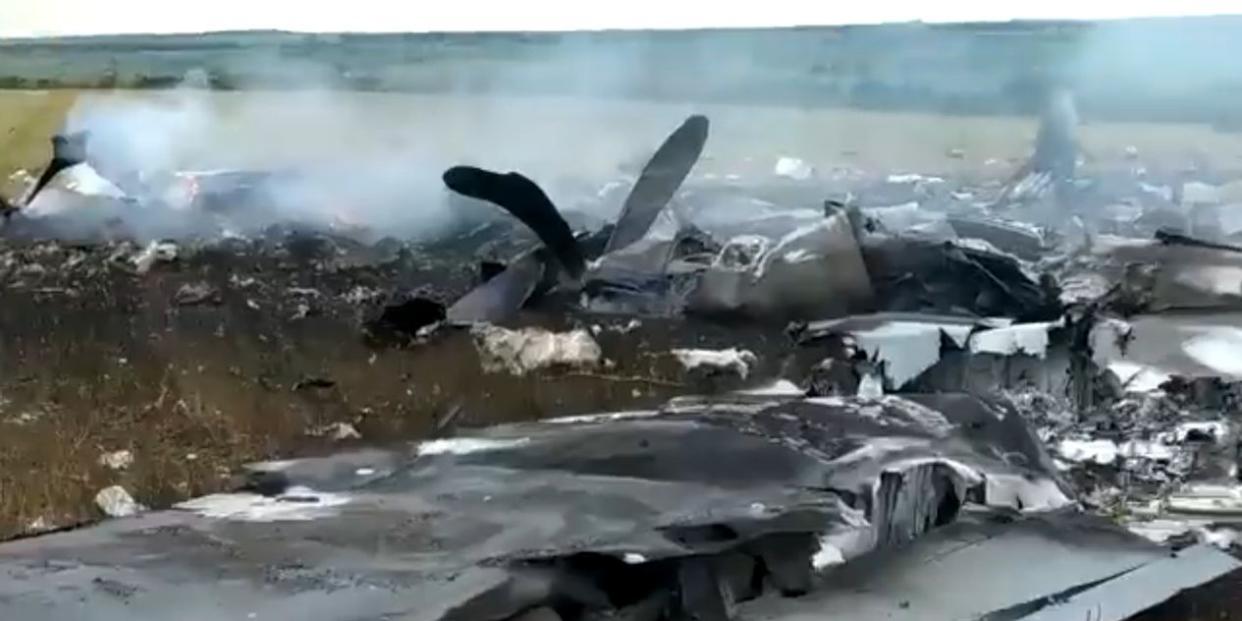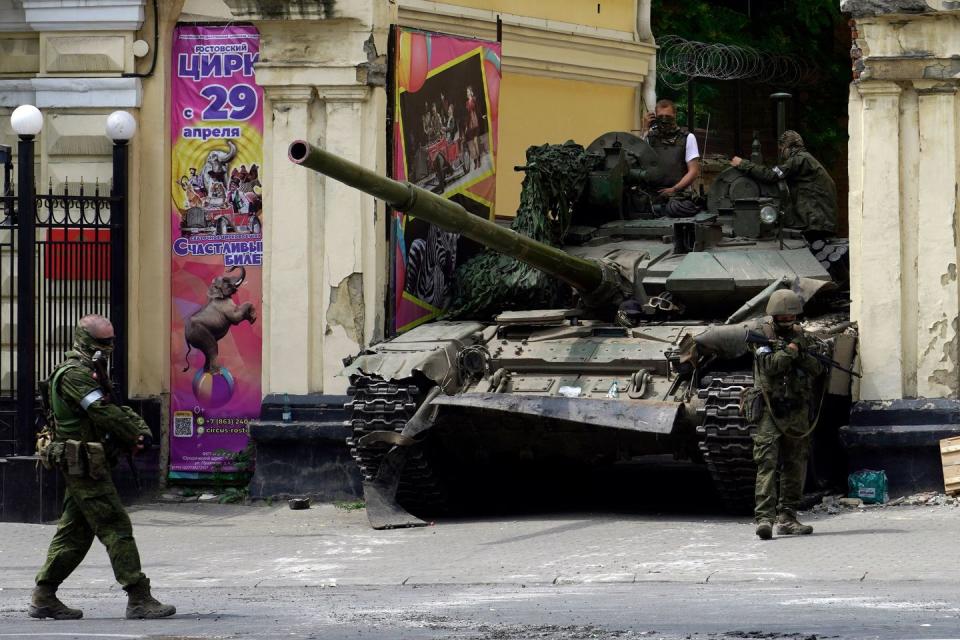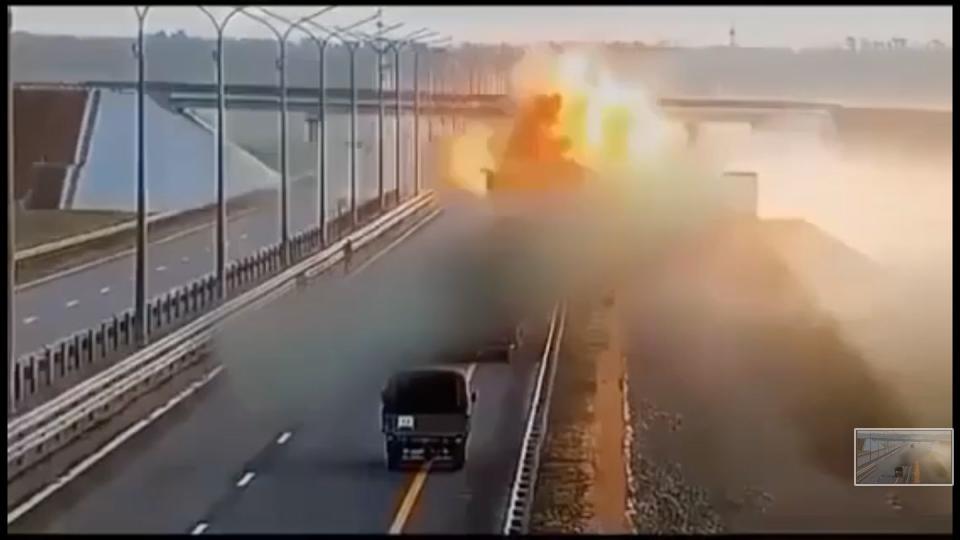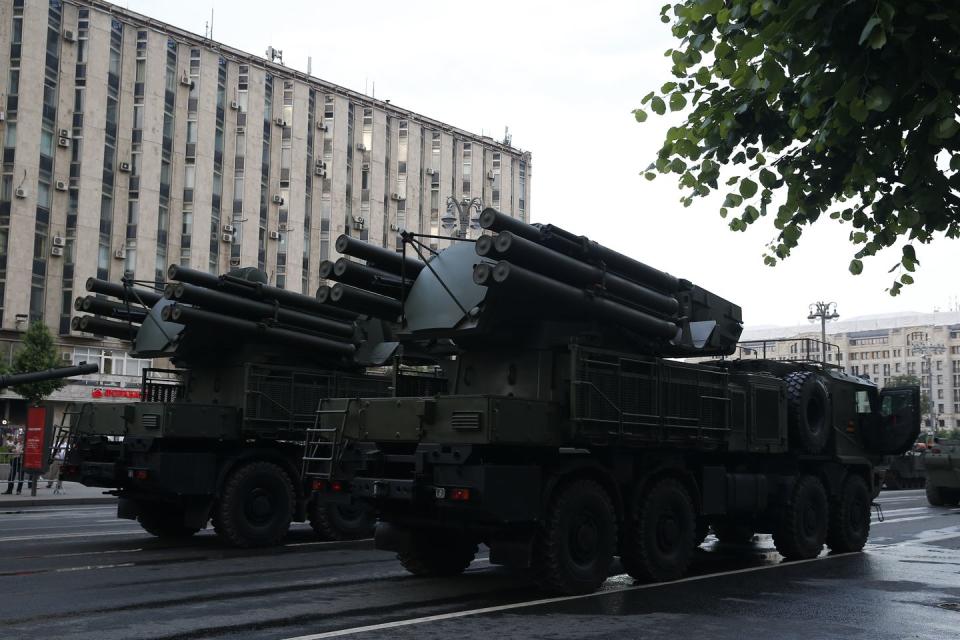The Wagner Mutiny Hit Russia's Air Force Hard. Really Hard.

- Oops!Something went wrong.Please try again later.
Last Friday, Yevgeny Prigozhin, a businessman-turned-warlord controlling Russia’s globe-spanning Wagner private military company and its tens of thousands of mercenaries, launched an armed mutiny aimed not so much at overthrowing President Vladimir Putin but, rather, the leadership of Russia’s defense ministry.
While Prigozhin claimed that Russia’s military had intentionally shelled his mercenaries, the underlying conflict was due to plans by Russia’s ministry of defense to convert much of his manpower into regular army service, as well as Prigozhin’s increasingly open personal attacks against unpopular Russian defense minister, Sergei Kuzhugetovich Shoigu.
Prigozhin himself joined a mechanized force—including T-80BV and T-90s tanks—which surrounded and seized control of the Russian military headquarters in Rostov, a city of one million that serves as the logistical base for Russian forces invading southeastern Ukraine.
Separately, a column of Wagner troops counting over one hundred trucks went barreling down the M4 highway towards Moscow.
Twenty-four hours later—after Putin promised to “brutally” deal with a henchman he now described as a back-stabbing traitor in a public address—the relationship was patched over in a deal supposedly proposed by Belarussian dictator Alexander Lukaschenko. Charges of armed rebellion against Prigozhin were dropped, he would move to Belarus, and some of his troops would still be absorbed by Russia’s military while others may be transferred to Wagner’s extensive overseas deployments, particularly in Africa.
Never mind the seven Russian military aircraft reportedly shot down and 13 Russian air force (VKS) pilots killed by Wagner anti-aircraft fire, as reported by pro-Russian military sources. The full claimed count includes:
2 attack helicopters (Ka-52 and Mi-35)
1 armed transport helicopter (Mi-8)
3 electronic warfare helicopters (Mi-8MTPR-1)
1 Il-22M airborne command post/comms relay plane
Indeed, the mutiny led the VKS to lose more in 24 hours than it had in several days of frontline combat against Ukraine’s counter offensive.
Two-way Ground Vs. Air Warfare
Russian armed forces on the ground—including army, Rosgvardia national guard and other internal security troops—evidently failed to shoot at, or even to simply obstruct, Wagner forces. So, it seems that all of the violence during the Wagner revolt occurred between VKS and Wagner’s ground troops.
Prigozhin’s column entering Rostov appears to have elicited an exchange fire late Friday evening. Prigozhin later claimed his troops opened fire because Russian helicopters mistakenly targeted civilian roadsters. His forces seized the airbase of Millerovo, but allowed personnel there to continue combat missions over Ukraine as long as a Wagner observer was onboard to prevent movement against Wagner forces—an inverted throwback to Soviet commisars (political officers).

But a more lethal imbroglio occurred on the M4 highway to Moscow as the Wagner column approached the city of Voronezh in the oblast of the same name.
This column was composed of over 100 vehicles—mostly military and civilian trucks, but also several MRAPS, T-72s, and T-80s mounted on tank transporters. Air defense included at least two truck-based Pantsir-S1 short-range air defense systems armed with both missiles and 30-millimeter cannons, as well as at least one less capable Strela-10 tracked armored air defense vehicle. (These systems are codenamed SA-22 Greyhound and SA-13 Gopher respectively.)
Heavy Wagner convoy with active air defense in Voronezh Oblast, moving with at least one Pantsir-S1 SAM system, Strela-10 SAM system, and multiple BMPs and tanks (T-72B3, T-80BV) loaded on equipment haulers. pic.twitter.com/pWiJKf4vcq
— OSINTtechnical (@Osinttechnical) June 24, 2023
It was here (and nowhere else) that Russian aviation seems to have knocked out at least five Wagner light vehicles: two 6x6 trucks, an MRAP, two machine-gun armed pickup trucks, and a mine-resistant MRAP style vehicle. Some strikes also apparently targeted infrastructure such as bridges to slow down the column.

Some of the attacks appear to have involved large gravity bombs, normally (but not exclusively) employed by fixed-wing jets. Though no jets are visible on video, one account claims that relatively modern Su-34 ‘Fullback’ bombers were employed.
One Russian Tiktok post shows a massive blast falling on a Wagner column.
Footage has emerged of the bombing of a highway near #Voronezh during the movement of the #Wagner PMC convoy towards #Moscow. pic.twitter.com/TgQmmhJ43i
— NEXTA (@nexta_tv) June 26, 2023
Another video recorded from within a civilian car shows a bomb detonating nearby, its shockwave flipping the car over. It’s unclear whether missing the road and bridge was intentional or accidental.
Footage from earlier today which shows the attempted Bombing and the Aftermath of a Highway near the Town of Brodove in the Voronezh Region by the Russian Air Force most likely to try and Halt the Advance of Wagner PMC Forces in the Region; it appears that the Bombs not only… pic.twitter.com/8zZgyd8VAz
— OSINTdefender (@sentdefender) June 24, 2023
A Russian Ka-52 Alligator helicopter—an advanced type know for its shark-like nose and double rotors—was also alleged to have destroyed a fuel storage depot on the eastern side of Voronezh, presumably in hopes of denying it uses by the column.
An explosion at an oil depot in Voronezh occurred at the time of a bypass of a Ka-52 helicopter of the Russian Aerospace Forces next to it. pic.twitter.com/t0OY8Sv63V
— Dmitri (@wartranslated) June 24, 2023
This attack was filmed from other angles too, including from a construction platform. Geolocation suggests that this incident took place at a major four-way intersection/overpass on the M4 highway at the eastern outskirts of Voronezh city.
One video shot by civilians at a nearby lineup of car dealerships shows both a Wagner Strela-10 air defense vehicle on the ground and a nearby flying Ka-52. Two surface-to-air missile launches are seen or heard, followed by the sound of an explosion.
It seems the mystery of how the fuel depot went up in #Voronezh is solved- a Wagner operated Strela-10 fired on a VKS Ka-52, but the likely 9M37-series missile missed and hit the depot.
Explains why the Ka-52 wasn't seen firing rockets, just dropping flares. pic.twitter.com/CZHZ1jx4qN— Cᴀʟɪʙʀᴇ Oʙsᴄᴜʀᴀ (@CalibreObscura) June 24, 2023
In the same area, perhaps this very same Ka-52 was recorded narrowly escaping a Wagner missile, thanks to its flare decoy.
A Russian Ka-52 'Alligator' attack helicopter survives a very close shave with a surface to air missile; the helicopter is saved by its flare countermeasures. pic.twitter.com/BSBVygYPeJ
— Jimmy Rushton (@JimmySecUK) June 24, 2023
There is an alternate theory, therefore, that the Strela-10’s 9K35 missiles or the Ka-52’s helicopter flares accidentally landed on the depot and caused the explosion, rather than it being a deliberate attack.
One way or another, at some point, Ka-52 Yellow 72 (serial number RF-13418) was shot down near Talovaya (southeast of Voronezh), killing the pilot.
#Russia: A Russian Ka-52 attack helicopter (72 Yellow, RF-13418) was reportedly shot down by Wagner forces near Talovaya, #Voronezh Oblast.
The crew was killed. pic.twitter.com/Tr3hPtvfH0— 🇺🇦 Ukraine Weapons Tracker (@UAWeapons) June 24, 2023
An older Mi-35 Hind gunship helicopter was also downed near Rostov after attacking the Wagner column (recorded here), but its two crew survived.
There are also reports of downing of an Mi-8 ‘Hip’ transport helicopter—which can be armed with rockets for ground attack missions—and damaging of an Mi-28 Havoc helicopter allegedly “holed” by Wagner fire.
Very rare Mi-8 MTPR shot down by Wagner. pic.twitter.com/Voesfw7izU
— Clash Report (@clashreport) June 25, 2023
But most puzzlingly, early in the mutiny, Fighter Bomber reported that Wagner downed two highly valuable Mi-8MTPR Rychag electronic warfare helicopters flying as a pair near Rostov/Millerovo. All of the crew survived, though one of the lost helicopters was consumed in flames.
#Russia: A helicopter (presumably Mi-8MTPR-1) of the Russian Ministry of Defense was shot down by Wagner forces today in #Voronezh Oblast.
Two of these electronic warfare helicopters were reportedly shot down in total. pic.twitter.com/mJfIsP41mU— 🇺🇦 Ukraine Weapons Tracker (@UAWeapons) June 24, 2023
The blog later reported the loss of a third Mi-8MTPR during the mutiny over Luhansk in Ukraine, near where Wagner’s Voronezh column had begun. The crash, pictured here, gave time for only one of the four crew members to parachute out.
Russia began the war with just 15 Mi-8MTPRs, which employ long-range jammers to drown out Ukrainian air defenses, degrading detection time and accuracy during Russian missile, drone and bombing attacks. Combined with two Mi-8MTPRs lost over Russian airspace nearly simultaneously in May to an ambush likely involving a forward-deployed Patriot missile battery, Russia has lot one-third of its heliborne jamming fleet.
Possibly as devastating was the downing of a large plane near Kantemirovka—likely a rare, specialized type fitted with advanced sensors and communications equipment.
#Russia: A Russian Il-22M communications aircraft (reportedly RF-75917) was shot down by Wagner forces in #Voronezh Oblast. pic.twitter.com/CKhy4KRXoh
— 🇺🇦 Ukraine Weapons Tracker (@UAWeapons) June 24, 2023
Multiple sources report that this was an IL-22M airborne command post plane often used to relay communications —possibly with serial numbers RF-75917—with eight crew aboard, none of whom survived. The Il-22M has neither weapons nor ejection seats. However, it could have been used to track and direct attacks against the Wagner column. Earlier in 2018, the Russian Air Force lost an Il-22M over Syria to friendly fire following an Israeli air strike.
Crash site of Il-22 of the Russian Air Force shot down by Wagner troops. pic.twitter.com/J8tcpix1YQ
— Aldin 🇧🇦 (@aldin_aba) June 25, 2023
However, the plane seen falling in the video appears to have only two engines, not the four of an Il-22. That could mean that the aircraft seen in the video may have been an An-24, an An-26, or An-140-100 transports.
How Did This Happen?
That VKS losses were so high led some to wonder why Ukraine’s air defenses have had less verifiable success during their counter offensives. Could Wagner’s prowess or equipment somehow explain the difference?
Wagner forces were seen disposing of four types of anti-aircraft weapons: heavy 12.7mm and 14.5mm anti-air machine guns (effective out to 1 miles), man-portable air defense systems (presumably Igla-S or Verbas, effective out to 3 or 4 miles), the Strela-10 tracked vehicle (with a range of 3 miles) and, most potently, the Pantsir-S1. The Pantsir uses 57E6 missiles with a max range of 9-11 miles, and relies on radio commands from the radar- and electro-optical sensor equipped truck for guidance.

Ukraine doesn’t have its own Pantsirs, but there are better explanations for the differences in counter offensive success. After heavy early-war losses, Russian combat helicopters ordinarily try to stay outside of—or dart only briefly within—the 2-4 mile range of portable air defense systems donated to Ukraine. The preferred weapons are unguided rockets fired in an arc and Vikhr long-distance anti-tank guided missiles that can target specific vehicles or fortifications.
However, those cautious tactics weren’t viable against the two Wagner columns advancing down Russian highways full of civilian traffic—the pilots needed to get closer to ID targets if they wanted to not accidentally blow up civilian buses or fellow Russian regular military vehicles. But that, in turn, exposed them to Wagner’s short-range missiles and heavy anti-aircraft machine guns. The Fighter Bomber blog, commenting on the video of the near miss of a civilian car, remarked that the convoys “were mixed with civilians, the air defense systems were deployed amongst car parks and busy stores.”
It’s still unclear why the valuable Mi-8MTPRs and the Il-22M—neither designed for direct combat—would have been dispatched to close within visual range of Prigozhin’s forces. The MTPR model even has the regular model’s armor removed. Presumably, they came under fire performing either a show of force or a reconnaissance mission, perhaps not realizing the kinetic escalation of the confrontation.
What's Next for the VKS and Wagner?
Several Kremlin-aligned Western propagandists have sought to cast doubt on the losses, whether out of denial rooted in motivated thinking (nobody likes to admit their preferred side suffered heavy losses), or as a deliberate deception tactic to muddy the waters and to maintain the laughable official line that Russia is “now more unified than ever” following what was humiliating and damaging mutiny.
But the reports of losses come from pro-war Russian sources—notably, the prominent Fighter Bomber social media account run by a former Russian pilot, and the Rybar telegram account. The videos and photos posted to social media come from horrified Russian civilians.
The losses to Russian pilots mean Wagner may face an even harder time calling for air support from the VKS. Historically, the VKS had actually loaned older ground attack jets—including A-10-like Su-25 Frogfoots and supersonic Su-24 Fencers—for use by former military pilots in Wagner’s employ. Prigozhin, as a stunt, flew a mission on an Su-24. Furthermore, Kanamat Botashev, a 63-year-old retired major general who died in May of 2022 when his Su-25 was downed by a Stinger missile over Ukraine, is believed to have been in Wagner’s employ.
That said, post-mutiny, the Wagner organization’s role in the Ukraine fighting seems set to dwindle rapidly. But, despite the de-escalation of the mutiny, it seems distinctly possible that Russia’s military and security services may look for means of retaliation against Prigozhin that won’t involve a major battle against Wagner fighters on Russian soil.
You Might Also Like

